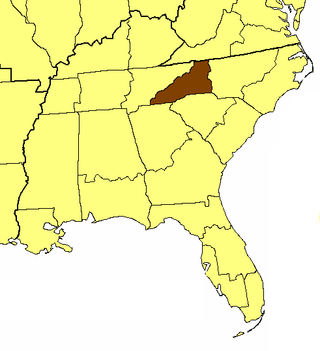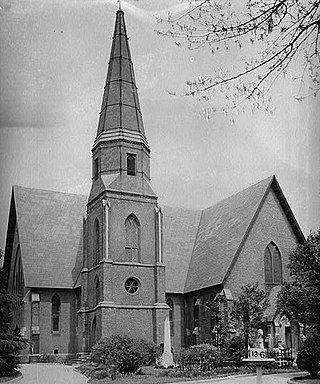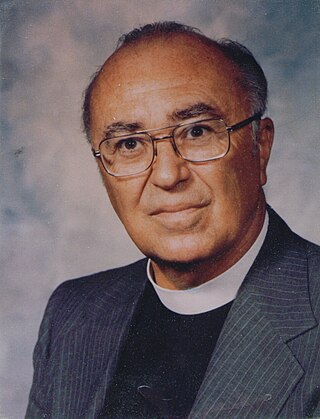
Watauga County is a county located in the U.S. state of North Carolina. As of the 2020 census, the population was 54,086. Its county seat and largest community is Boone. The county is in an exceptionally mountainous region, known as the High Country. It is the home of Appalachian State University, which has approximately 20,023 students as of August 2020. Watauga County comprises the Boone, NC Micropolitan Statistical Area.

Valle Crucis in an unincorporated community and census-designated place located in Watauga County, North Carolina, United States. The name of the town is Latin for "Vale of the Cross," a reference to a valley in the area where three streams converge to form a shape similar to an archbishop's cross. The community is located along NC 194, between the towns of Banner Elk and Boone.
William West Skiles (1807–1862) was an American missionary, a Deacon in the Episcopal Church, and a teacher and community leader. He helped to found the community of Valle Crucis, North Carolina and to establish the church and missionary center there.
Valle Crucis is a Latin phrase meaning "valley of the cross", and may refer to:
The Penland School of Craft is an Arts and Crafts educational center located in the Blue Ridge Mountains in Penland, North Carolina in the Snow Creek Township near Spruce Pine, about 50 miles from Asheville.

John Stark Ravenscroft was the first Bishop of the Episcopal Diocese of North Carolina and helped organize the Episcopal Diocese of Tennessee.

Levi Silliman Ives was an American theologian and Episcopal bishop of North Carolina. In 1852, he converted to Roman Catholicism. Ives subsequently became a noted professor at colleges in the New York area. He was the founder and first president of the New York Catholic Protectory, an institution for the shelter and education of destitute and abandoned children. He was also a founder of Manhattan College.

The Episcopal Diocese of Western North Carolina is a diocese in the Episcopal Church. It consists of 28 counties in western North Carolina and its episcopal see is in Asheville, North Carolina, seated at Cathedral of All Souls. The first recorded worship from the Book of Common Prayer west of the Catawba River was in 1786. Valle Crucis, where one of the two conference centers is located, began as a missionary outpost in 1842. In 1894, a resolution was adopted in the Convention of the Diocese of North Carolina that the Western part of the state be set aside and offered to the General Church as a Missionary District. The following year, in November 1895, the first Convention of the District of Asheville was held at Trinity Church in Asheville. In 1922, after all the requirements had been fulfilled, a petition from the Jurisdiction of Asheville to become the Diocese of Western North Carolina was presented at the General Convention of The Episcopal Church. It was accepted on September 12, 1922.

The Mast General Store is a general store located in Historic Valle Crucis, North Carolina. It is recognized by the National Register of Historic Places as one of the best remaining examples of the type. It is still the center of the community housing the post office and offering coffee for 5¢ on the honor system. {As of|2020}} the business had expanded to eleven locations, including the original Store and annex, both located in Valle Crucis, North Carolina. The store sells commodities such as old-time hearth and home goods, outdoor clothing and gear, footwear, work clothes, old-fashioned wind-up toys, regional books and music, honey, and more than 500 varieties of old-fashioned candy.

Chapel of the Cross is a parish of the Episcopal Church of the United States in Chapel Hill in the Diocese of North Carolina. It is the spiritual home to more than 1,600 communicants, including numerous students studying at the University of North Carolina at Chapel Hill.

Christ Episcopal Church, also known as Christ Church on Capitol Square, is an Episcopal church at 120 East Edenton Street in Raleigh, North Carolina. Built in 1848–53 to a design by Richard Upjohn, it is one of the first Gothic Revival churches in the American South. The church was built for a parish established in 1821; its minister is the Rev. James P. Adams. It was declared a National Historic Landmark in 1987.

Christ Church (Episcopal) is an Episcopal church in Greenville, South Carolina, United States. which was consecrated in 1854. The church and its courtyard are listed on the National Register of Historic Places as Christ Church (Episcopal) and Churchyard. It is the oldest organized religious body and the oldest church building remaining in Greenville.

Thomas Atkinson was the third Episcopal Bishop of North Carolina.
Hobart Brown Upjohn (1876–1949) was an American architect, best known for designing a number of ecclesiastical and educational structures in New York and in North Carolina. He also designed a number of significant private homes. His firm produced a total of about 150 projects, a third of which were in North Carolina.

North Carolina Highway 194 (NC 194) is a primary state highway in the U.S. state of North Carolina. Entirely in the High Country, it runs from US 19E, in Ingalls, to the Virginia state line, near Helton.

Valle Crucis Historic District is a national historic district located at Valle Crucis, Watauga County, North Carolina. The district encompasses 50 contributing buildings, 1 contributing site, and 7 contributing structures in the central business district and surrounding residential sections of Valle Crucis. It developed between about 1812 and 1954, and includes notable examples of Gothic Revival, Bungalow / American Craftsman, and Colonial Revival style architecture. Located in the district are the separately listed Mast General Store, Mast Farm, and Valle Crucis Episcopal Mission. Other notable contributing buildings are the Baird Farm, Lucy Mast Olsen House (1936-1940), Taylor tobacco barn, Farthing Store (1909), Valle Crucis Bank (1914), Hard Taylor House, and C. D. "Squire" Taylor House (1911).

William James Hadden Jr. was a Protestant minister of the Christian Church and a priest of the Episcopal Church He was also at different times both a military chaplain, and a university Chaplain. He also served as a politician and community leader in Pitt County, North Carolina, and worked for the desegregation of Greenville, North Carolina.

José Antonio McLoughlin is the seventh and current bishop of the Episcopal Diocese of Western North Carolina, United States. After studies at Virginia Theological Seminary, he was ordained to the diaconate and priesthood in 2005.
Oliver Sherman Prescott was a prominent American Anglo-Catholic priest and activist who was active in the foundation of the Society of St. John the Evangelist. He was born in New Haven, Connecticut, and baptized by Harry Croswell at Trinity Church on the Green in that city. Prescott attended Trinity College, Hartford from 1840 to 1842 and Yale College from 1843 to 1844; he was graduated from the General Theological Seminary in New York in 1847 and made a deacon that year at Trinity Church in New Haven. He considered himself a protégé at the General of Professor Clement Clarke Moore.

Cameron Farquhar McRae was an Episcopalian minister who served as the rector of different parishes in North Carolina, Massachusetts, Pennsylvania, Georgia, and Maryland.


















